Menu
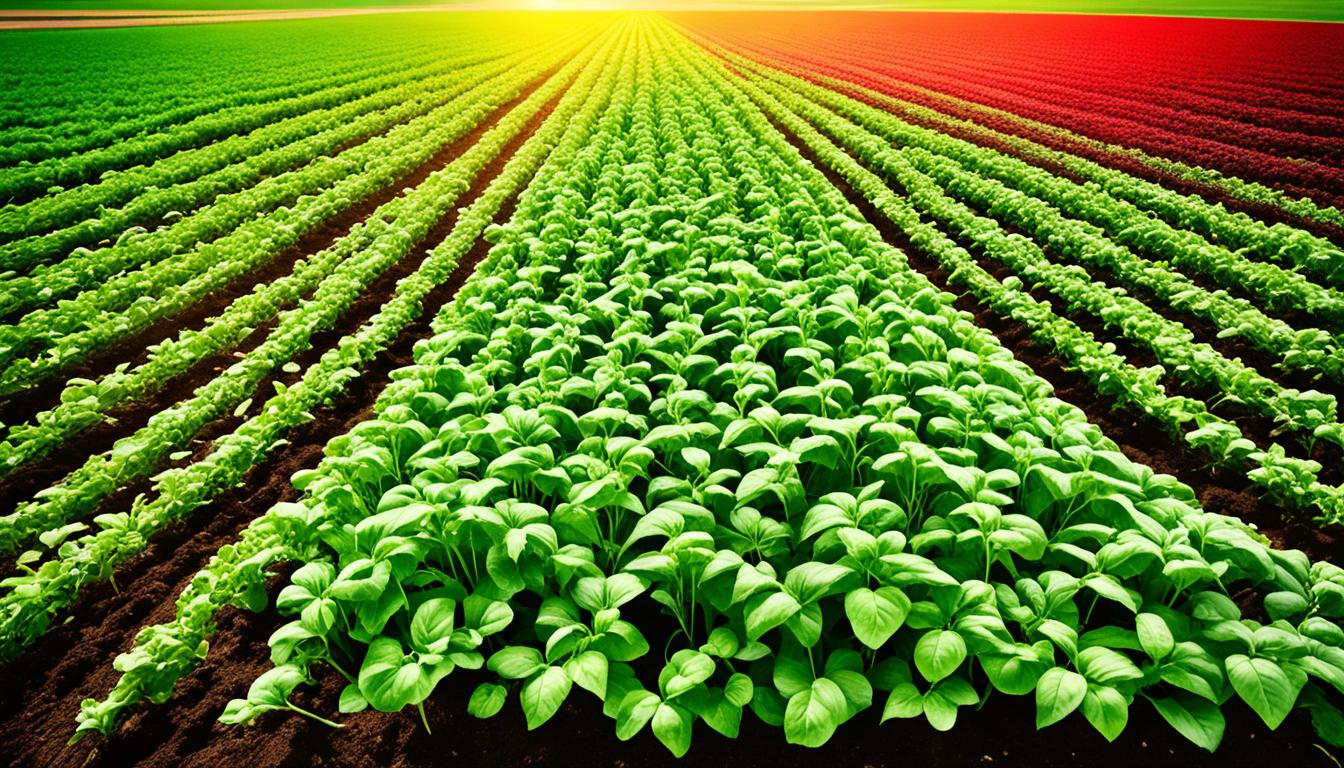
Between 1996 and 2012, GM crops made a big positive impact on the world’s income. This influence was in the billions of dollars. The link between sustainable farming and biotech crops is interesting for those keen on both areas. It shows how using things like genetic modification and careful farming can raise crop amounts. This is crucial as the world deals with feeding more people using limited resources.
I investigate the joint space of biotechnology and eco-friendly farming as a journalist. I want to explore the different aspects of GMOs and bio-engineered crops. This will include looking at new science, ethical talks, and the effect on the environment. I aim to offer a detailed look at how using biotechnology in farming can help us make a better, greener future.
Biotechnology has greatly changed modern farming. Particularly, it’s thanks to genetically modified crops. They have increased crop yields and lessened the impact on the environment. Now, we farm in ways that better meet the world’s growing food needs.
Genetically modified crops have boosted how much food we can grow. Studies show these crops can yield more while keeping their nutrients. Thanks to crops that resist weed killers, farming has become more efficient. Key foods like maize, rice, wheat, and soybeans have seen their yearly yields grow. This proves that using biotechnology helps us grow more food.
Looking at the big picture, we must think about the environment when using biotechnology. By 2030, the world population will hit 9 billion, and the planet’s getting warmer. This is where biotech steps in to help. Genetically modified crops use resources better and cut down on using harmful pesticides. This means lower pollution and farming more sustainably.
Using helpful microorganisms in farming can make the soil healthier. This, along with using less chemicals and waste, helps the environment. A good farming technique should be good for the planet, make money, and care for people. This is the real power of biotechnology in farming, creating a better future for all.
The world of agriculture biotechnology is changing fast. Scientists are tweaking the genes of crops to make them better. Through this, crops produce more, taste better, and can fight off bugs and bad weather. This change is like the big shift the green revolution caused in the 1970s, increasing how much food we can grow.
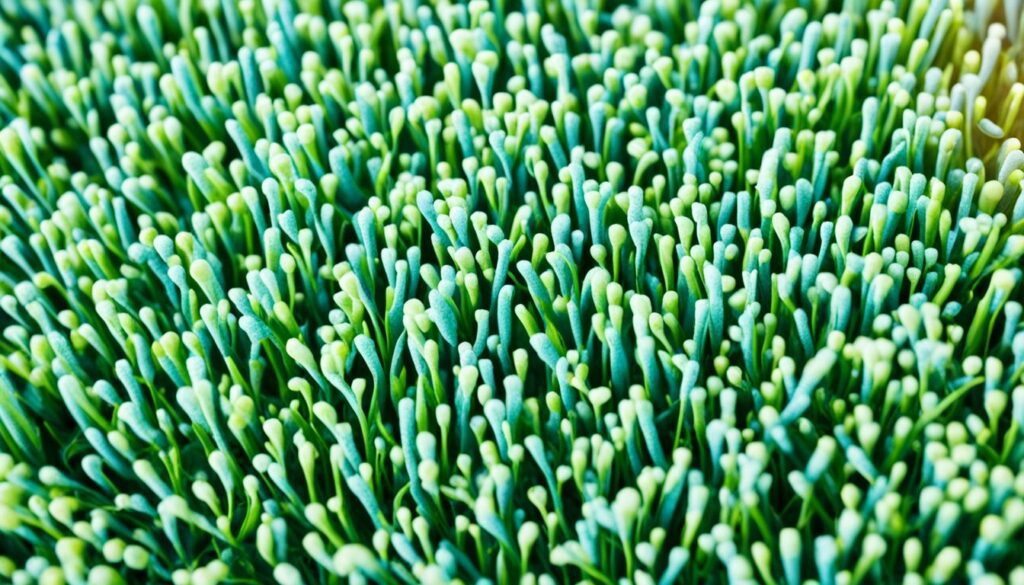
Using genetic engineering, experts are making crops that can handle tough times like droughts and bugs. They do this by directly editing the plant’s DNA. This way, they can tweak exactly what they want without mixing in genes from other species. It’s like upgrading the plants in a very targeted and controlled way.
Genetic engineering is helping to beat problems that used to limit how well our crops grew. By adding in genes that protect against harsh conditions, we can grow food in places it couldn’t grow before. This not only makes our food supply safer but also helps our farms deal with the effects of climate change.
But, not everyone is sure about GMO crops, especially in Europe and the Middle East. It’s important to carefully study and address worries about their safety. This is crucial for finding common ground and building a future where farming is sustainable for everyone.
Since the 1990s, genetically modified crops have been part of big farming. The first ones helped tobacco plants fight disease and made a tomato that people could eat safely. Now, you’ll find a variety of plants like cantaloupe and cotton that have been given the okay by the FDA. These show us the good things that changing plants through agriculture biotechnology can bring.
Genetically modified organisms (GMOs) spark big conversations about ethics and the environment. People worry about unexpected outcomes, who owns the technology, and big companies controlling farming.
One concern is whether GMOs are safe to eat for a long time. Many ask if they could harm our health, leading to lots of talks between scientists and the public. The fact that big companies own most of these crops doesn’t sit well with everyone. It can lead to less choice for farmers and reduce the number of different plants we grow.
GMOs can have good and bad effects on the environment. For example, since 1996, the use of pesticides worldwide has gone down by 8.3% because of GMOs. But, in places like the US, Brazil, and Canada, some weeds are now harder to kill by herbicides. This happened because GMO crops that can survive herbicides were used a lot. So, these weeds got stronger. However, using GM cotton that fights off bugs meant we used 331 million kg less insecticide.
Here’s a snapshot of how GM crops have affected the environment:
| Year | Reduction/Increase |
|---|---|
| 1996-2018 | 8.3% decrease in pesticide use |
| 1997-2018 (Canada) | Decrease in herbicide use for GM HT soybeans |
| 2007-2014 (Brazil) | Increase of 4,940,262 kg of herbicide use |
| 1996-2018 | 34.2% improvement in EIQ for GM IR cotton |
It’s clear we need to carefully watch how GMOs are used and managed. We must protect our environment while enjoying the good GMOs can bring.
Modern agriculture has changed a lot due to GMOs. They have made crops more resistant to diseases. This means we see less loss in staple crops. And, it’s not just about higher yields. It also makes our food supply safer by lowering the use of pesticides and toxins.
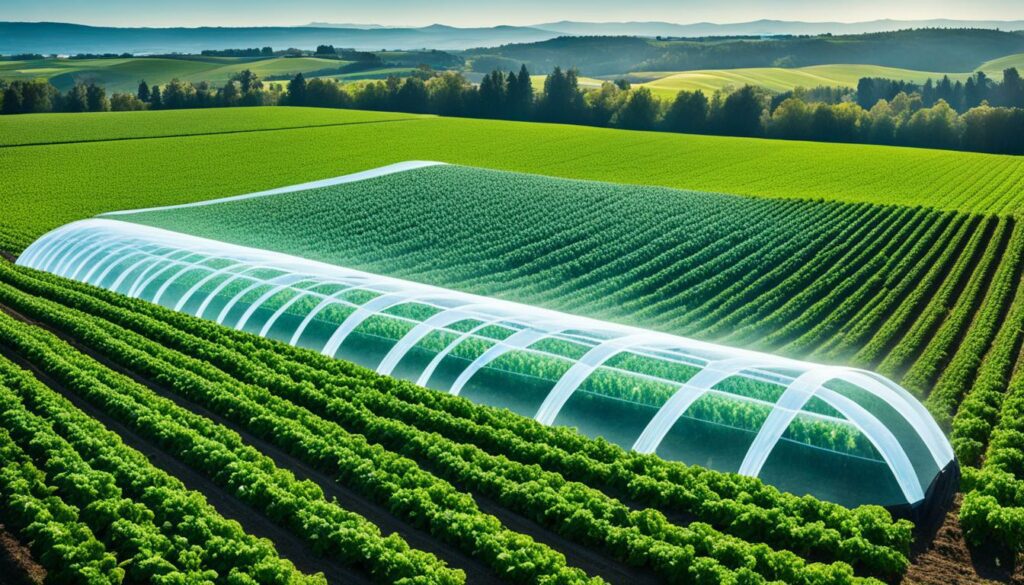
Biotechnology plays a big role here. It has brought us crops that can handle more herbicides and resist bugs. For example, cotton, soybeans, and corn have been changed to use less synthetic pesticides. In 2012, most of the corn, cotton, and soybeans in the US were genetically modified. Using less traditional pesticides is key to keeping agriculture sustainable.
GMOs help farmers get better yields. They keep more of the harvest safe from diseases. This is good for the economy of farming. It means farmers can spend less on fixes and more on making money.
These GMOs are also great for the environment. Using fewer pesticides keeps water and soil cleaner. It helps protect the wildlife. Biotech crops need fewer resources like fuel and water. They reduce a farm’s impact on the planet. This is big for making farming sustainable and natural.
New technologies in agriculture are a game changer. They help solve food and environmental problems. The mix of higher yields and less harm to the planet shows how important biotechnology is for the future of farming.
The use of nutritional enhancement GMOs is key in tackling global malnutrition and increasing food security. By adding vital nutrients to crops, biotechnology helps make our diets better, especially in places where people lack essential nutrients.
We can fight malnutrition by making staple foods like rice, wheat, and maize more nutritious. Genetically modified crops can now contain extra vitamins and minerals. This improves the health of many, with ‘Golden Rice’ being a great example. It fights vitamin A deficiency with its special gene that makes vitamin A. And, the good news is, these special crops don’t produce less food, so we can feed more people.
To feed the world well, we need not only more food but food that is more nutritious. By using biotechnology to tweak crop genes, we can make our food better for us. This is super important because by 2030, there’ll be 9 billion mouths to feed. Crops like Roundup Ready soybeans show us how quickly we can make these improvements happen.
Below is a table summarising how crop improvements help food security:
| Metric | Past Data (1960-1990) | Current Trends | Projected Impact |
|---|---|---|---|
| Global Cereal Yields | Doubled | Optimised with GMOs | Improved Nutritional Value |
| Rice & Wheat Yields | Dramatic Increase | Enhanced in Asia | Addresses Malnutrition |
| Water Use | Tripled | More Efficient Use | Sustainable Practices |
| Primary Agriculture Workforce (U.S.) | 60% in Early 1900s | <1% Today | Increased Mechanisation and GMOs |
Advances in nutritional enhancement GMOs and biotechnology are vital for our food’s future. By using genetic tweaks carefully, we can feed more people healthily. This approach also supports a sustainable future in farming.
Precision agriculture is a big step in managing farms better. Farmers can now use high-tech tools to save resources and cut back on waste. This helps make farming more sustainable and efficient.
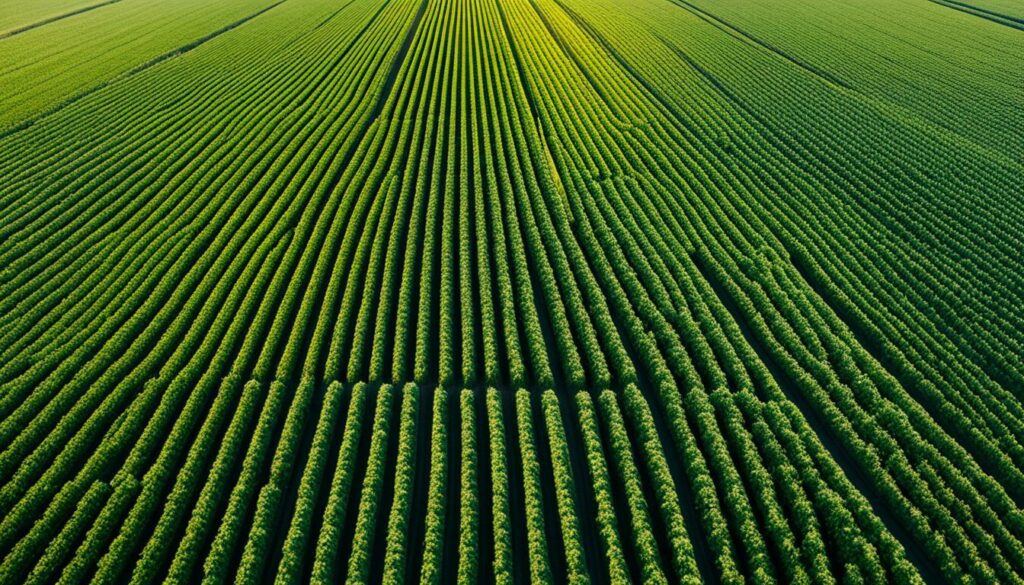
Precision agriculture focuses on using resources like water and fertilisers smartly. It uses sensors and data to make better choices. Farmers can grow more food while using fewer resources this way. It’s about farming wisely to take care of the earth for the future.
Data-driven farming is great at finding and dealing with waste. Tools, like satellites and drones, give farmers specific advice. This advice helps use less water and fertilisers, making farming better for the planet. The goal is to keep farming diverse and improve the lives of everyone involved.
By 2050, we need to produce 70% more food for the growing global population. Precision agriculture and data-driven farming are key solutions. They make farming sustainable and efficient to meet this huge challenge.
Field trials are crucial for testing GMO crops. They give us essential data on how well these crops grow and how they affect the environment. Conducted since the 1980s, these trials look at things like better yields and resistance to pests.
During 1986 to 1995, a global look at GMO plant tests showed their value in agriculture. From 1996 to 2018, GMO crops helped reduce pesticide use and carbon emissions. This highlights the need for GMO field trial evaluation in making farming more sustainable.
Field trials let us test GMOs in different climates and environments. For example, using CRISPR-Cas9 to edit the genes of semi-dwarf bananas or to add resilience to crops. These trials prove the effectiveness of these new methods.
Testing modified barley that uses less synthetic fertilisers is another example. This shows the importance of field trials in changing how we do farming in the future.
Field trials are monitored by departments like the Department for Environment, Food & Rural Affairs (Defra) and its Advisory Committee on Releases to the Environment (ACRE). They ensure GM crops are safe and meet high standards. The findings are published in scientific journals, confirming the benefits of these crops.
These trials thoroughly check GMOs in every aspect. From how they grow to their effects on the environment and how people accept them. This detailed review is key to making GMO crops a common and beneficial part of agriculture.
A deep study shows the real advantages of GM crops. It looks at both the farming and money sides.
Using GM crops has cut pesticide use by 37%. This shows GM crops are good at fighting off pests and diseases.
GM crops that resist insects work best at this. They cut the use of chemicals more than herbicide-ready crops do.
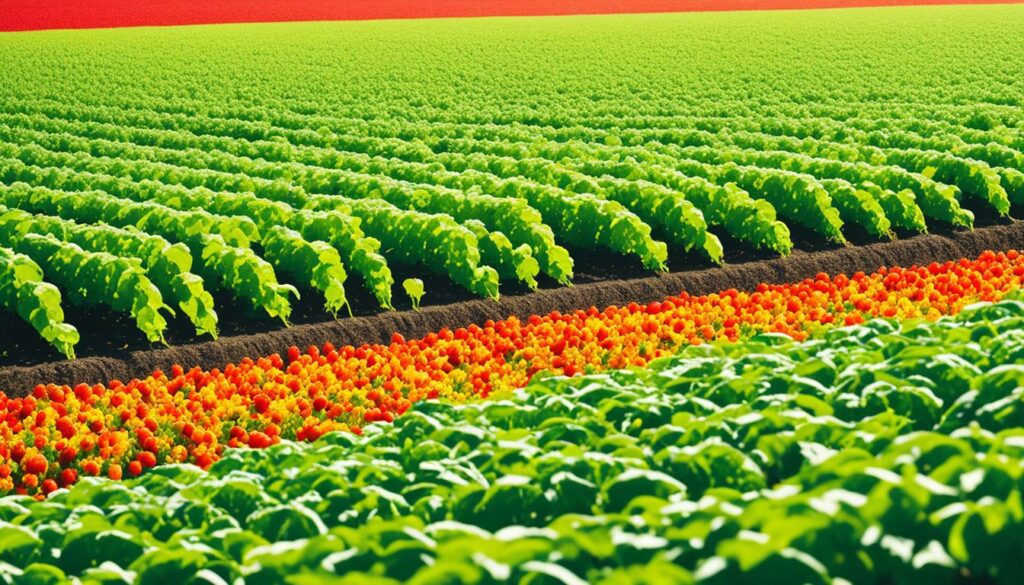
Thanks to GM crops, yields have grown by 22%. Crops that keep insects away have done better than those that fight weeds with herbicides.
Places that are still developing have seen the most gain. This proves GM crops help feed more people and boost farming where it’s needed most.
By using GM crops, farmer earnings have jumped 68%. This is a big deal for farmers in poorer countries.
Less spending on pesticides and more crops to sell have made a big economic difference. It helps not only the farmers but also the wider farming industry.
| Aspect | Impact | Details |
|---|---|---|
| Pesticide Use Reduction | 37% | Major benefit with insect-resistant GM crops. |
| Crop Yields Increase | 22% | Higher yield gains in developing countries. |
| Farmer Profits Increase | 68% | Significant economic benefits for small-scale farmers. |
The meta-analysis checked 147 studies from many places and crop kinds. By 2016, 12% of the world’s farming land had GM crops. Developing areas used them most.
These findings show how big a role GM technology plays worldwide. They prove the need to keep studying its farming and financial effects on farmers everywhere.
Bioengineered crops have changed farming by adding advanced biotechnology. Since the early days of genetic modification, these changes have deeply affected food production.
Genetically engineered (GE) crops like U.S. corn, upland cotton, and soybeans are over 90% of the market. This shows how important biotech is in today’s farming. For example, by 2023, most soybean crops could withstand herbicides.
In cotton and corn, growth has been impressive too. In 1997, only about 10% of cotton was herbicide-tolerant. This improved to 94% by 2023. Likewise, HT corn jumped from almost none to 91% in the same period. Insect-resistant Bt cotton and corn also saw big growth.
The idea of making plants better is very old, around 10,000 years. But in 1946, scientists found they could move genes between species. This was the start of genetic engineering as we know it. The first genetically modified crops were tobacco and petunias that could resist antibiotics. _GMO technology_ soon led to China selling genetically modified tobacco in 1990 and the FDA approving the Flavr Savr tomato in 1994.
Besides making crops stronger, _GMOs_ have made some foods more nutritious. By the mid-90s, crops like cantaloupes and cotton could resist pests. This opened the path to changing even more crops for the better, including rice, lettuce, and sugarcane. These changes help meet the world’s growing food needs in a sustainable way.
| Crop Type | Adoption in 1997 | Adoption in 2023 |
|---|---|---|
| HT Soybean | 17% | 95% |
| HT Cotton | 10% | 94% |
| HT Corn | Initial Slow Rates | 91% |
| Bt Corn | 8% | 85% |
| Bt Cotton | 15% | 89% |
| Stacked Variety | Initial Slow Rates | 86% Cotton, 82% Corn |
These changes in farming have been huge. As our knowledge of genetics and ability to improve crops increases, we can create even better and more nutritious food. The growth in _GMO use_ is solving big issues like hunger and how to farm sustainably.
Biotechnology plays a key part in improving soil health and looking after the land. It helps farmers keep their soil full of nutrients. This means they can grow crops well over a long time. By doing this, they also help take care of the land.
The changes biotechnology brings are very helpful. They do a lot to help keep the soil healthy. This way, the soil stays good for growing food. It also means the land can be used by farmers for many years.
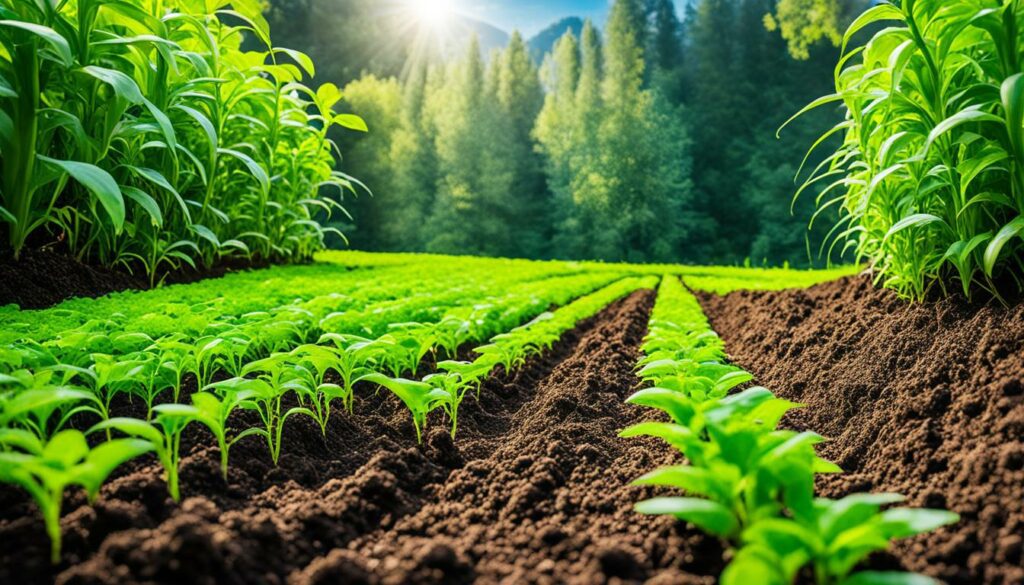
Rotating crops is vital for the health of the soil. Different crops give and take different things from the soil. So, by changing what grows in a field, the soil stays rich.
Biotechnology helps farmers pick the best crops to grow next to each other. It makes the soil better and helps cut down on using chemicals. Plants that can handle weed killers break down easily in the soil. This keeps the top layer of soil strong and stops it from being washed away.
Looking after the soil for a long time is the aim. Biotechnology helps make crops that need less help to grow well. This means they don’t need as many pesticides. For example, some kinds of cotton can fight off insects on their own.
This is good news for the water and the environment. Less chemical use means the water stays clean. And the land’s natural balance is not upset by too many chemicals.
Biotechnology also makes farming systems stronger. It changes the plants to make the soil healthier. Then, the soil can support bigger harvests. More farmers are using these new ways. In the US, most farmers use biotech plants for corn, cotton, and soybeans. This shows that farmers believe in these changes for the better.
For more insights on the impact of biotechnology on agriculture, visit the USDA’s frequently asked questions page.
Agriculture is in its fourth revolution thanks to new information and communication technologies. Remote crop monitoring, using drones and satellites, is key to this change. These new tools are making farming more efficient and sustainable.
Drones in farming have special sensors and cameras. They can take pictures and analyse crops using different kinds of light. Farmers can now check on their crops’ health and stress levels. They can then act quickly to fix any problems. This way of farming is much more detailed than before, thanks to these new tools.
Analysing satellite images adds even more power to this technology. These methods are getting better, even though they’re not always fast or accurate yet. But they’re getting there. With more and better data, predicting crop yields will improve. This will help farmers make smarter choices, leading to more sustainable farming worldwide.
Biotechnology has changed how we deal with pests in farming. It uses the power of nature to fight against pests. By adding natural enemies into the genetic code of plants, we get an eco-friendly way to deal with pests. This method doesn’t need as many chemicals, helping the environment.
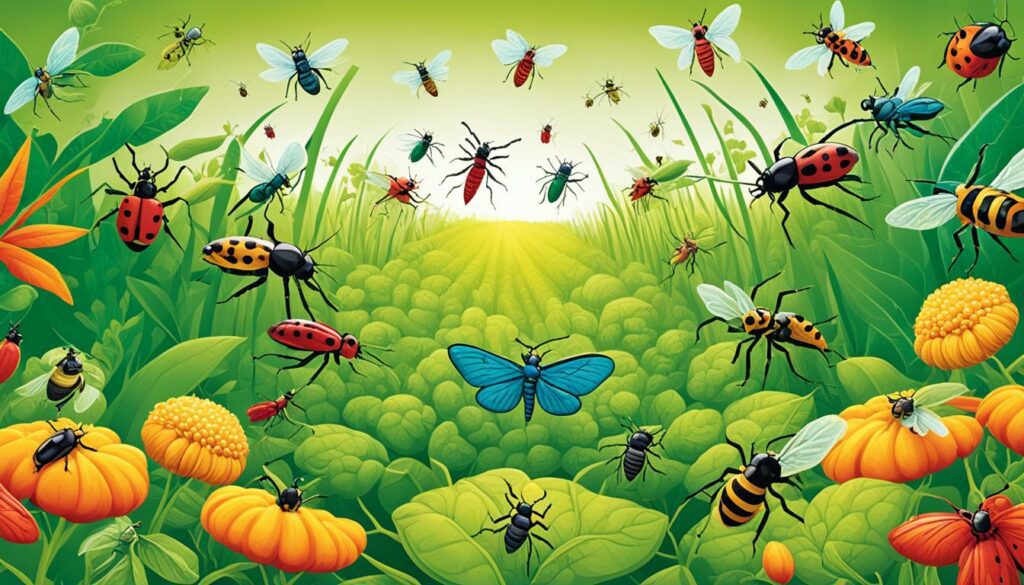
For example, some plants now make a protein called Bacillus thuringiensis (Bt). This protein kills certain bugs but is safe for us and animals. It’s found in crops like cotton, corn, and soybeans. In the U.S., most of these crops use this technology.
This method also cuts down on the use of chemicals to kill bugs. In places like China, growing Bt cotton has reduced the use of bug sprays a lot over five years. This not only saves money but also helps our planet.
But biotechnology doesn’t just fight bugs. It also makes crops better. For example, adding beta-carotene to rice or making canola oil healthier. This shows how biotechnology can help in many ways.
It’s also important that groups like the USDA, FDA, and EPA watch over these new plants. They make sure the plants are good for us and the world before they can be sold.
Using biotechnology in pest control is a big step for farming. It’s not only good for reducing pests but also for looking after our planet. This new way of farming is a key part of making sure we can all have enough food in the future.
Biotech crop research is at a turning point, with big opportunities but also big hurdles. Looking ahead, we must deal with rules and new tech that guide this field’s future.
Biotech faces hurdles in the complex world of rules and policies. Sometimes, strict rules slow down the making and selling of genetically changed crops. Finding the right balance between safety, trust, and speed in innovations is tough. The drop in biotech crop use in 2019, from the previous year, highlights this issue. Rules need to change fast to keep up with new science.
Biotech’s new tools, like genome editing, are very exciting for making crops last longer and give more food. Over time, the use of biotech crops has grown a lot, covering 2.7 billion hectares by 2019. These changes are critical for fighting malnutrition. Over two billion people have serious nutrition problems. Special crops can have the vitamins and minerals needed to avoid these health problems.
“The impact of iron deficiency alone is staggering. It leads to anaemia in 40% of all women and 50% of pregnant women, contributing to 40% of the half-million maternal deaths annually during childbirth.”
New technology brings a lot of hope, but we must also strengthen the rules and policies to make them safe and effective. Balancing innovation with safety opens new doors for biotech research.
| Country | Hectares (millions) | Adoption Rate |
|---|---|---|
| USA | 72.9 | 95% |
| Brazil | 52.8 | High |
| Argentina | 24 | High |
| Canada | 12.5 | High |
| India | 11.9 | High |
Looking at the USA, Brazil, Argentina, Canada, and India, we see they lead in biotech. In 2019, they covered 91% of the world’s biotech crop area. Their high use shows biotech’s success in farming, guiding other countries.
By mixing new tech with better rules, the future of biotech crops looks bright. Overcoming the challenges can lead to new ways for us to grow food sustainably and keep the world fed.
My biotech crop sustainability analysis looks at how we balance new biotech methods with caring for our natural resources. The way we farm is changing to make food more secure and lessen harm to the environment. Genetically modified (GM) crops play a big role in this change.
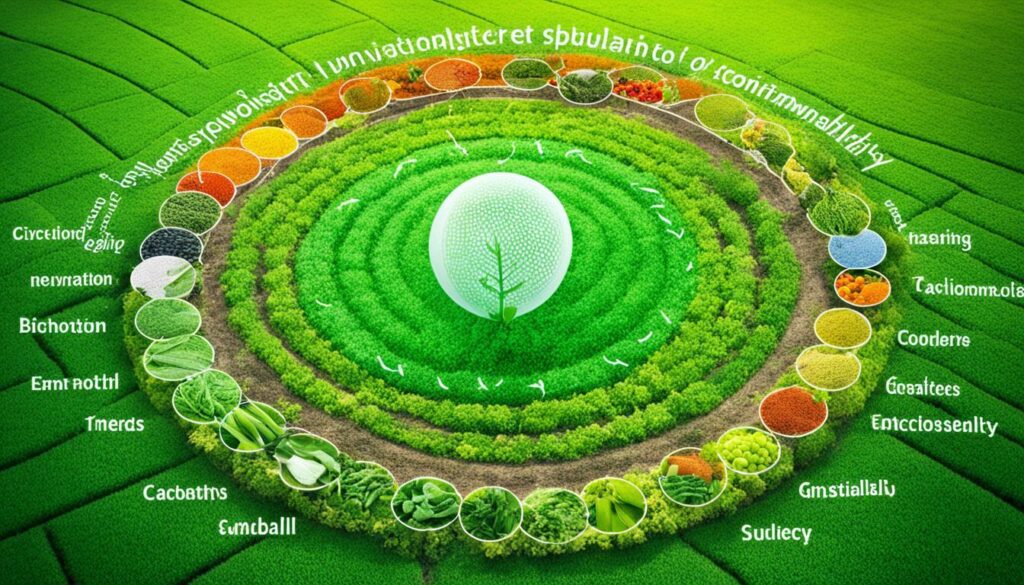
In 1997, the Economic Research Service found that GM crops that could resist herbicides and pesticides led to more crop output. In Iowa, Bt corn GM crops grew 160.4 bushels per field. This was more than the 147.7 bushels per field from non-GM seeds. GM crops clearly boost farming’s productivity.
When we look at the 1996 to 2012 period, GM crops have had a clear positive effect on income and production worldwide. GM soybean crops, for example, brought in $208.42 per acre, which is higher than non-GM crops at $191.56. In places like Tennessee and North Carolina, GM herbicide-resistant soybeans made more money than normal soybeans.
The ISAAA Brief No. 46 for 2013 showed the important role of GM crops in making agriculture globally more stable and sustainable.
Using GM crops has meant using less pesticide and herbicide, except for glysophate, which increased. This change is good for the planet because it means less harmful chemicals in our environment. It also shows we need to use different strategies to control pests if we want our farming to be sustainable.
| Impact | GM Crops | Non-GM Crops |
|---|---|---|
| Yield (bushels/acre) | 160.4 (Bt corn) | 147.7 |
| Net Value ($/acre) | $208.42 (GM soybeans) | $191.56 |
| Pesticide Use Reduction (%) | Significant decrease | – |
But, there are problems that we need to solve. Contract issues, like not being able to save seeds, and legal disputes, like the case of Monsanto vs. Schmeiser, show that GM farming has its own challenges. We also need to be careful about creating weeds that resist our efforts and making sure space is left for natural crops, which is something the EPA has to watch.
So, my biotech crop sustainability analysis shows it’s vital to move forward with biotech in a way that is both ethical and good for the planet. This way, farming can be ready for the future and help make sure we all have enough to eat.
The world of agricultural biotechnology is complex but full of promise. It has helped increase crop yield and improve the quality of nutrients. With research, we have seen crops that resist certain herbicides, making weed control easier.
Key crops like maize, rice, wheat, and soybean are growing better every year. Yet, they aren’t improving enough to meet our growing food needs. By 2030, we’ll have 9 billion people to feed, with climate change affecting farming. So, biotechnology’s future is critical for feeding the world and adapting to a changing climate.
Biotechnology also plays a big part in making farming sustainable. By adding good microorganisms to our soil, it helps keep the soil healthy. The US leads in research, focusing on crops that grow well in tough climates. They’ve made corn and wheat that can survive drought, and cows that can handle heat.
Although genetic modification faces challenges, new tools are making things better. Genome editing and precision farming show promise for the future. But it’s important to think about the impact on the environment and ethics. We need to make sure biotechnology helps us produce food without harming the planet for our children’s children.
Biotech crop sustainability is about using technology to boost farming. It aims to grow more crops, protect the environment, and make sure there’s enough food. Genetic modification helps crops grow better and gentler on the planet.
Biotechnology changes crop genes to fight off pests and survive droughts. This makes farms more productive by overcoming nature’s limits.
Modified crops need fewer chemical pesticides and use resources better. This means a cleaner environment, healthier soil, and more plants and animals.
People worry about GMOs for food safety, their impact on nature, and big companies owning them. We need strong rules and talk to handle these worries.
GMOs make crops stronger against bugs and diseases. This way, we use fewer harmful chemicals, and farms do better with less harm to the environment.
Yes, biotechnology helps add more nutrients to crops, fighting hunger, especially where people lack key nutrients. This makes a big difference in those areas.
Precision farming uses high-tech tools to plan better, use less and do more with what’s available. This is a big step for farming to be smarter and kinder to the planet.
Field trials check how well GMOs grow and if they help the environment. They teach us a lot about using these crops wisely across different lands.
Looking at many studies, biotech crops cut down pesticide use, help grow more food, and boost money farmers make. This is especially good for farmers in poorer countries.
Bioengineering has come a long way, with new editing tools and crops that are packed with nutrients. These are vital for feeding more people in sustainable ways.
Through better crop rotations and changed genes, biotechnology keeps soil healthy. This is key for keeping the land fertile and strong for growing food.
Drones and satellites watch crops, predict good harvests, and help when things go wrong. They’re making farming more precise and better for the planet.
By putting natural predator genes in plants and making eco-friendly bug-killing sprays, biotechnology helps keep pests in check safely. This is good for the environment.
Big hurdles are slowing down new GMOs because of tough rules. We must find common ground and change regulations to keep making new, good solutions.
Biotechnology is central to eco-friendly farming, making crops stronger, food safer, and nature safer. It aims to feed the world without harming the Earth.